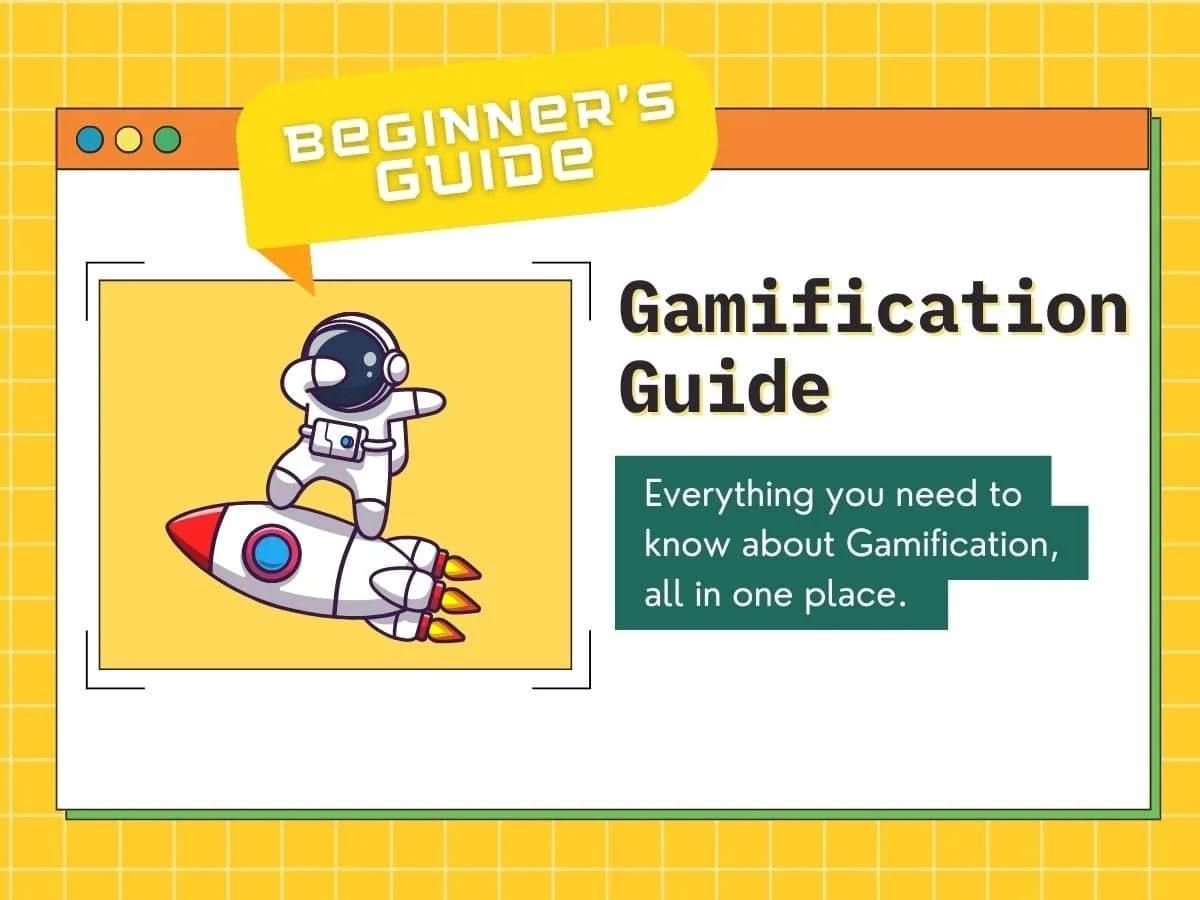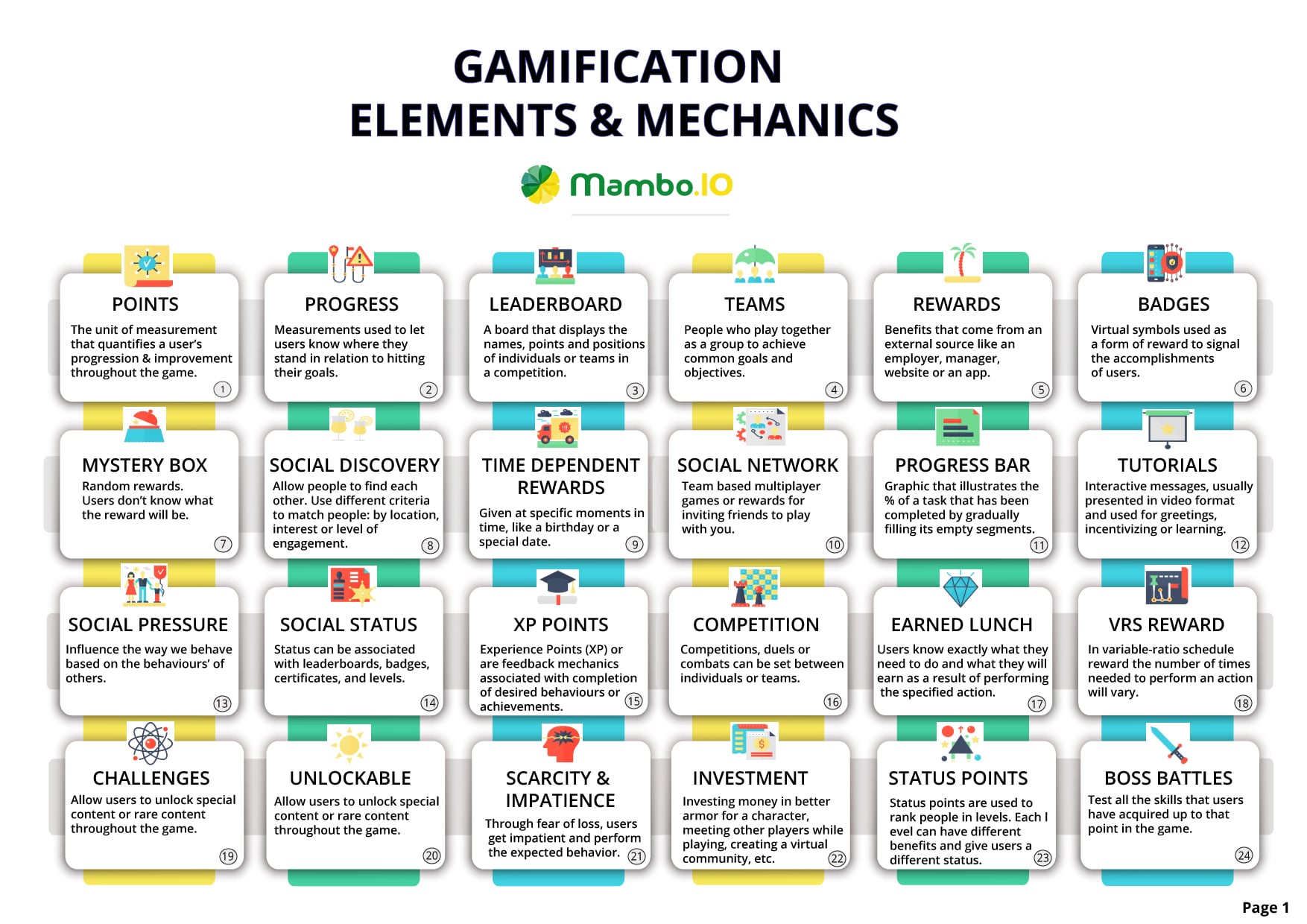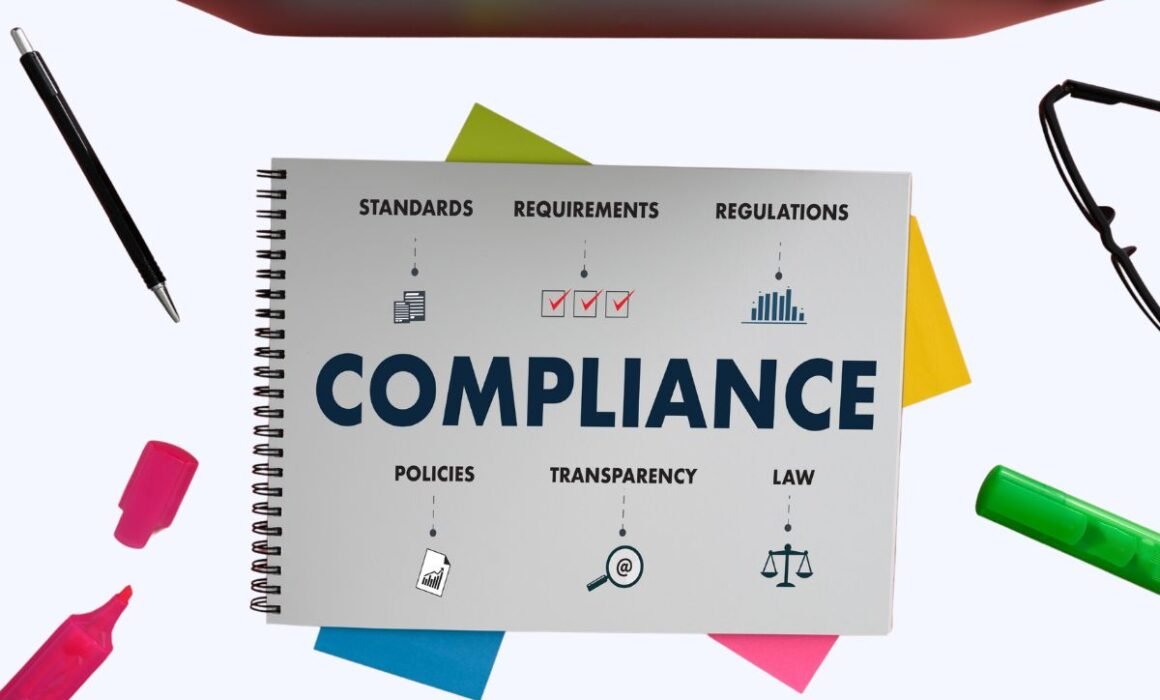19 Awesome Gamification Ideas – Ted Talk Edition
G
Gamification ideas are popping up.
In today’s post, we are sharing 19 awesome TED Talks to inspire new gamification ideas.
How is Gamification changing the way people work, learn, or complete tedious and repetitive tasks? Check out how some brilliant Gamification ideas that are inspiring and empowering others to do their very best.
Table of Contents
- Gamification ideas are popping up.
- Gamification Ideas for Business
- Gamification Ideas For Motivation in General
- 5. Gamification to Improve our World – Yu-kai Chou
- 6. Gamification – How to Make Change Inevitable and Fun – Tom van Dijk
- 7. The Game that can Give you 10 Extra Years of Life – Jane McGonigal
- 8. Seven Ways Games Reward the Brain – Tom Chatfield
- 9. Your Brain on Video Games – Daphne Bavelier
- 10. Gamification: the Motivating Spark – Joe Houde
- 11. Life Lessons…From Video Games – Karl Kapp
- 12. The Future of Creativity and Innovation is Gamification – Gabe Zichermann
- Gamification Ideas For Government
- Gamification Ideas For Community
- Gamification Ideas for Education
- 15. The Power of Gamification in Education – Scott Herbert
- 16. Blowing up the Gradebook – Using Video Games for Learning – Chris Haskell
- 17. Unboxing Education Through Gaming, Playing, and Making – Lucien Vattel
- 18. The Effective Use of Game-Based Learning in Education – Andre Thomas
- 19. The Gamification of Education – Emmett Stone
- Machine Learning In Finance: 12 Essential Applications
- How To Create Interactive Compliance Training For Bank Employees
- How Fintech Apps Are Using Gamification To Increase User Engagement
- Top Gamification Companies for Employee & Customer Engagement
Download your free
“Gamification Guide”
Get your PDF now and start transforming your approach to digital engagement!
Click here to see the ultimate list of gamification examples.
Gamification Ideas for Business
1. Gamifying Blue Collar Work – Sean Dessureault
In blue collar work, productivity and safety are the rule of thumb for businesses. However, tedious and boring tasks can seriously compromise an employee’s engagement and attention.
How can we reverse this situation and bring joy, effectiveness and safer conditions to these workers?
Thinking of a solution, Sean Dessureault developed an engagement strategy using Gamification as the key solution.
Now Sean is no stranger to mining having been himself been a front line miner. He has a PhD, automation researcher, mining engineer, who has also worked as professor of Mining and Geological Engineering.
In his Ted talk, Sean talks about his Gamification idea that used game elements such as achievements, scoreboards, feedback, teamwork and competition, mixed with the mining operation’s most important KPIs.
Sean Dessureault
He points out that “no matter where we bring this technology, from the highlands of peru to jungles of Ghana as soon we introduce gamification and show how it works they immediately start to ask oh how can I get more points” (15:42).
Interesting Points
07:08 What made highly competitive managers to compete, even though they were in different departments?
06:21 Find a way of making using data addictive
8:31 The value of gamification for blue-collars work and IOT (internet of things)
10:47 A constant sense of feedback through accomplishment
14:32 The importance of a scoreboard
16:13 Frequent feedback and social aspects of teams and reviews
Download your free
“108 Gamification Elements and Mechanics”
Get your cheat sheet and have a quick reference at your fingertips!
2. Gamification at Work – Janaki Kumar
Janaki Kumar is an outstanding innovator, working to transform user experience for SAP America. In this TED talk, she champions the idea of merging play with work.
Work and innovation shouldn’t be boring. Ms. Janaki uses vivid examples such as modern hybrid and electric cars developing a method to have drivers compete against each other to lower emissions, and fitness trackers like Fitbit and Apple watch using gamification to encourage people to exercise more.
Janaki Kumar
She says gamification can help companies “foster a culture of learning”, encourage “employees who are doing tough or repetitive tasks” and recognize “employees who are going beyond their job descriptions” (12:33).
Interesting Points
1:42- Gamification as a mindset.
5:53- Mixing play and work.
7:26- The need for employee engagement.
10:19- Gamifying the call center experience.
11:43- How Microsoft used gamification to improve its software.
12:58- Critics of gamification.
3. Gamification is Key to Nudging Collective Behaviour – Kerstin Oberprieler
As a leading gamification academic, practitioner, and design expert, Kerstin Oberprieler is trying to push the boundaries of what is possible with gamification mechanics. She aspires to use game mechanics to engage people and to solve real world problems.
In this TED talk, Kerstin Oberprieler introduces the “MessMonster”. An innovative game she developed to empower people to clean messy areas. She says before MessMonster cleaning was kind of annoying, but after MessMonster cleaning was kind of fun, because it engaged people to capture monsters and rewarded them.
Kerstin Oberprieler
Ms. Oberprieler also introduces 4 orders of gamification, which is her framework to “better understand, implement and evaluate gamification experiences” (7:11). With increasing complexity, the four orders are: “playful design”, “transactional gamification”, “social gamification” and “systemic gamification”.
Interesting Points
1:07- Game mechanics.
2:00- How Gamification encourages peoples to exercise more.
4:06- MessMonster.
7:17- The four orders of gamification.
9:50- How China uses systemic gamification.
11:23- Gamifying our school system.
12:05- Gamifying environmental sustainability
4. Gamification of Human Resource – Chin Ren Yi
How can businesses motivate their employees to go the extra mile? Chin Ren Yi, a young Malaysian entrepreneur provides some answers to this question using the example of ‘MyBurgerLab’, a restaurant company he co-founded with his friends.
In his Ted Talk, Ren Yi talks about the different ways his company keeps its staff motivated. He specifically talks about introducing “level up cards” to inspire and reward his employees. How can employees get a card? He says they “need to be able to open, run, close and teach” (12:50) each station of the business perfectly, before they can receive a card. The cards work as a form of psychological acknowledgement of the staff’s competence and they also come with a financial reward for the employee
Chin Ren Yi
He talks about a future in which his company would attempt to merge gaming with the Myers–Briggs Type Indicator test, so that every employee can be more suited to the roles they perform within the company.
Interesting Points
3:03- Starting a business.
4:19- Building a good business ecosystem.
6:04- Starbucks experience.
12:05- Gamifying work.
14:13- Gamifying experience and loyalty.
15:33- Myers–Briggs Type Indicator for work.
Gamification Ideas For Motivation in General
5. Gamification to Improve our World – Yu-kai Chou
How can you create exciting games? Yu-kai Chou, a young entrepreneur, author and trailblazer in the gamification industry, addressed this question by proposing a gamification framework, which he termed, “Octalysis”. Like the shape of an octagon, this framework comprises 8 core drives to add fun to both your game and your life.
In this TED talk, Yu-kai Chou questions why some games are boring even when built on new game elements and technologies. He advocates for re-imagining gamification around the core drives of “epic meaning and calling”, “development and accomplishment”, “empowerment of meaning and feedback”, and “ownership and possession”, among others.
Yu-Kai Chou
While these core drives are crucial for building exciting games, they can also help to transform our lives by adding fun and entertainment to it.
Interesting Points
1:50- What is Gamification?
3:20- The Octalysis Framework
5:58- Feeling accomplished through games.
7:12- Solving a science problem with a game.
8:23- Can children learn basic math through games?
12:00- Speed count lottery and driving safer.
6. Gamification – How to Make Change Inevitable and Fun – Tom van Dijk
Tom van Dijk proposes a global adoption of gamification elements to get people to change their behaviours.
In this TED talk, Tom van Dijk introduces his four elements of gamification. The first is “Call to action” which involves challenging a person to improve their behaviour. He gives an example of a truck driver, saying you can challenge him by asking if he wants “to be the best truck driver in Europe”. The second element is about “Engagement”, and the third is about “Progress”. For “progress”, he says the truck driver can be rewarded “with all kinds of points”. Finally, “Positive emotion” is also important to change people’s behaviours. This involves making “the truck driver feels so good about his behaviour that he wants to show it again, and again, and again” (5:11).
Tom van Dijk
Mr. Tom proposes using these gamification elements to “save our world” from problems like climate change.
Interesting Points
0:24- Our behaviours.
1:20- The difficulty of changing behaviour.
1:39- Using game elements to change behaviour.
3:28- How does gamification work?
3:58- The four elements of gamification.
6:04- How we have all been involved in gamification.
6:47- Call to action – to change our world through gamification
7. The Game that can Give you 10 Extra Years of Life – Jane McGonigal
In this spirited TED talk, Jane McGonigal takes the audience through several interactive activities to boost their lifespan.
Jane McGonigal details how she battled suicidal thoughts with the help of a game, which she later named “SuperBetter”. She says the game helped her and many others with “post-traumatic growth”. Using science to prove her point, she further explains how a we can use a traumatic event as “a springboard to unleash our best qualities and lead happier lives”.
Jane McGonigal
She mentions 4 SuperBetter quests to increase the lifespan of people. The quests are: “physical resilience” which involves not sitting still, and “mental resilience”, which involves “tackling a challenge without giving up”. Furthermore, “emotional resilience” is about creating powerful positive emotions, and social resilience means you “get more strength from your friends, your neighbours, your family, your community” (15:58).
Interesting Points
0:17- Increasing the viewer’s lifespan by seven and a half minutes.
03:00- The top 5 regrets of the dying.
3:57- Family benefits of games.
6:00- Personal story about wanting to die.
9:30- The SuperBetter game.
12:09- The 4 ways to boost post-traumatic growth.
16:53- How to live 10 years longer.
8. Seven Ways Games Reward the Brain – Tom Chatfield
In this TED talk, Tom Chatfield talks about the engaging and addictive power of video games, and how we can “take these lessons from games and use them outside of games” (8:19).
Tom Chatfield mentions 7 powerful lessons from video games. The first lesson is to use “experience bars” to measure progress. The second is the “multiple long and short-term aims”, which involves giving people “people lots and lots of different tasks” at once. Next is to “reward effort”. He says “Every time you do something, you get credit; you get a credit for trying. You don’t punish failure. You reward every little bit of effort”.
Tom Chatfield
Other lessons include “feedback”, and “the element of uncertainty”, among others. He describes the element of uncertainty as a “neurological goldmine”, “because a known reward excites people, but what really gets them going is the uncertain reward, the reward pitched at the right level of uncertainty” (10:28).
Interesting Points
0:40- The video game industry.
1:09- The amount of money spent on buying virtual items in video games.
2:37- Emotional rewards from video games.
08:28- Experience bars measuring progress.
09:53- How games use feedback to reward the brain.
10:27- The element of uncertainty in games.
12:25- EverQuest video game.
9. Your Brain on Video Games – Daphne Bavelier
Daphné Bavelier is a Professor of cognitive neuroscience at the University of Geneva. In this fascinating TED talk, she immerses the audience into her lab; using practical cognitive tasks to justify the benefits of games.
Professor Bavelier debunks many of the commonly held beliefs about video games. She argues that action video games can actually improve our vision, our attention, and our ability to multitask
Daphne Bavelier
She also separates multimedia-tasking from actual multitasking. She defines multimedia-tasking as people “listening to music at the same time as they’re doing search on the web, at the same time as they’re chatting on Facebook with their friends. She says multimedia-taskers are “absolutely abysmal at multitasking”. But “people that play a lot of action games are really, really good. They switch really fast, very swiftly. They pay a very small cost” (10:16).
Interesting Points
0:34- Are video games only played by children?
0:50- what is the average age of video game player?
3:40- How video games impact our vision.
5:15- Do video games lead to attention problems?
7:02- Yellow and blue attention task.
10:20- Action games and multitasking.
11:55- Why general wisdom carries no weight for games.
14:10- Mental rotation.
10. Gamification: the Motivating Spark – Joe Houde
Joe Houde is an expert on action learning and game-based learning. In this TED talk, he gives a passionate justification for the adoption of gamification in all areas of our lives.
Using several examples from psychology, he summed up the definitions of gamification into 3 aspects that “help to motivate and engage us”. He says the aspects are, “the objective”, “the choice” and “the people” (5:07)
Joe Houde
“The objective” are the point system or goals in most video games. “The choice” is what provides meaning to games. Choices can either ratchet up the outcome of games, or provide “consequences within the game”. Finally, “the people” we play with are also a big motivator for playing games. Mr. Houde mentions the Robbers Cave experiment to buttress his point about the importance of people to games.
Interesting Points
1:14- Linking the Hyper Curve to gamification.
4:58- The three aspects of games.
7:38- Blackjack and choices in games.
9:59- The Robbers Cave experiment and games.
14:05- How the city of Tulsa gamified a health program.
14:26- Using gamification to change the small space around us.
11. Life Lessons…From Video Games – Karl Kapp
Most people only discuss the negative aspects of video games. Professor Karl Kapp disagrees with this mindset, and he uses compelling stories to explain the positive aspects of video games.
In this Ted talk, Professor Karl Kapp explains how video games can improve our decision making, mental acumen and technical skills. For example, he says “the game Minecraft is being used to teach math and geometry” (2:55) and people who play action based video games like Assassin’s Creed “have ability to make decisions 25% faster without sacrificing accuracy as people who don’t play action based video games” (3:28).
Karl Kapp
He recalls a personal gaming experience with his son, in which instead of flying his airplane during takeoff, his son instead drove the plane through the ocean to avoid being shot down. He summed up his experience by saying his son “had found a flaw in the game that was so outside of my realm of consciousness.
Interesting Points
0:28- Lessons from the Roller Coaster Tycoon game.
2:42- Positive aspects of video games.
3:00- Benefits of World of Warcraft, Minecraft and other games.
5:32- How a game helped with HIV research.
6:40- The third person perspective.
10:59- Homework for the listener/viewer
12. The Future of Creativity and Innovation is Gamification – Gabe Zichermann
We can push the boundaries of innovation by deliberately taking the ideas of games and applying them to people’s lives, “making the world a more interesting, more dynamic, more creative place”. These are some of the ideas shared by Game Zichermann, a public speaker, entrepreneur and author of ‘The Gamification Revolution’.
In this Ted talk, Gabe Zichermann talks about the several incredible benefits of gamification. He explains how the game ‘Eterna’ empowered regular people to discover thousands of new RNA structures that scientist never did. He also mentions the impact of Philo, a game created in Canada, on the study of DNA. He says “players of Philo have discovered approximately 350,000 potential mistakes in our understanding of the structure of DNA” (6:46).
Gabe Zichermann
He further explains how the idea of “easy failure” in games is a powerful tool to driving creativity and innovation. If you fail at a game, you simply start over. This is the opposite of failure at school and work, which are usually severely punished.
Interesting Points
3:28- What is fluid Intelligence?
4:02- How games motivate our brains.
10:15- The power of failure.
11:29- How games teach us.
12:50- Lessons from Autodesk.
15:02- Using gamification in the real world.
Gamification Ideas For Government
13. What if Government Was a Game? – Gianluca Sgueo
How can Governments adopt gamification to develop better policies? In this TED talk, Sir Gianluca Sgueo, a Global Media Professor at the New York University in Florence, explains how gamification can be used to improve public policies.
In this TED talk, Professor Sgueo explains how generations of humans have used games to advance policy making. He talks about “three main trends that are driving the use of game in governments” (6:26). The first trend is the power of technology, the second is the demand for instant response that modern technology has created, and the final trend is the desire of governments to reduce the cost of governance.
Gianluca Sgueo
He went on to predict an “increasingly gamified” future of governing (9:05).
Interesting Points
2:48- Examples of how governments/policy makers have adopted gamification.
5:15- Gamification in ancient Rome.
5:35- How Napoleon used a contest to invent food preservation.
9:28- What are the risks of a gamified government?
11:59- Social credit score and the black mirror model.
13:39- Advantages and disadvantages of a gamified government.
Gamification Ideas For Community
14. Community Gamification. Can it Work? – Cory Downs
Cory Downs is a sustainable specialist with the city of Chula Vista in California. In this TED talk, he passionately talks about greenhouse gas emissions, and the impact it is having on the climate and environment.
He talks about a future 5-degree increase in global temperature levels, which scientist have predicted. Should this happen, he says “it would bring a lot of impacts. Impacts like up to 144 million people forced to migrate away from their homes. Or a 77% increase in the size of California wildfires” (2:13).
Cory Downs
To reduce the chance of leaving the world with such a future, he advocates for the adoption of gamification to engage individuals, cities, states, and even countries. He says following this approach could lead to “billions of people taking actions to improve their quality of life, clean the environment and push back the global disaster” (9:04).
Interesting Points
0:34- Climate Change and pollution.
1:11- The warmest years on record.
2:50- How greenhouse gases impact us.
7:03- How to solve the Climate and environmental problem.
8:39- Connecting communities to battle climate change.
9:21- Using gamification and play to preserve the environment for the next generation.
Gamification Ideas for Education
15. The Power of Gamification in Education – Scott Herbert
Our education system is going through an engagement crisis. Scott Herbert, a teacher at Fort Saskatchewan in Canada, uses his personal experience as a teacher to explain the failures of the modern education system, and how we can change it.
In this TED talk, Scott Herbert talks about his struggle to get his students to care more about school. He talks about speaking with his students and asking them how to make school more interesting. He summed up their responses into 3 main lessons. First, educators must give students a reason to care about school because kids are tired of boring, repetitive topics. Secondly, kids feel like they have no choice in anything.
Scott Herbert
Finally, educators need to trust the creativity and passion of students by giving them more control over what they learn and how they learn.
Interesting Points
0:15- The stagnancy of education.
3:25- Education in an engagement crisis.
05:53- Lessons from students about improving education.
09:36- Bringing play to education
13:55- Backlash from innovating education.
16. Blowing up the Gradebook – Using Video Games for Learning – Chris Haskell
Predicting a revolutionary future for global education, Dr. Chris Haskell argues for the termination of the current grading system, which punishes failure and fails to make kids knowledgeable. He is an expert on training teachers to meet modern challenges.
In this TED talk, Dr. Chris Haskell lays out the challenges of our current educational system, and argues for the adoption of gamification to overcome it. He says “all students ask that natural question: what do I need to do to get the grade that I want, rather than what is what knowing, and feeling, and thinking, and doing” (9:07).
Chris Haskell
He proposes a different class system he designed with his colleagues. He says, “instead of letter grades, we just deal with experience points. We allow and reward failure” (10:15). He called this system, “Quest-Based Learning”. And after testing this system for two and a half years, his team saw a “93% success rate” and students completing twice as much work in “30% less time” (15:45).
Interesting Points
1:20- Educational experience.
2:08- Why schools are broken.
02:35- Schools of future.
04:09- Distance education in American history.
07:45- The power of games.
8:26- What if school was more like a game?
11:50- A new grading system for education.
17. Unboxing Education Through Gaming, Playing, and Making – Lucien Vattel
Can students learn complex concepts like constant velocity, aerodynamics and planetary science through games? Lucien Vattel, an exceptional innovator and founder of GameDesk, provides answers to this.
In this TED talk, Lucien Vattel explains the impact of finding an easier way to teach complex subjects. He introduces some innovations from GameDesk, such as the simulator to teach kids to imitate the flight of birds – aerodynamics, and to musically teach planetary science by creating a game where kids can “musically accrete” their own planets, and become “a planet DJ”. They would be able to “DJ the plates and form the alps, and form volcanoes, and form the world” (10:30).
Lucien Vattel
He also introduces a game to help with emotional intelligence and emotional management. He says through this game the player learns “body techniques, mental techniques in which to calm your body and actually get connected to who you are and how you react to different stimuli” (14:25).
Interesting Points
0:44- Defining education.
1:43- Tracing the history of modern education.
3:50- Using GameDesk to make a difference.
4:34- Teaching Constant Velocity through games.
5:53- Teaching through MotionPlay.
9:11- Simulating aerodynamics.
18. The Effective Use of Game-Based Learning in Education – Andre Thomas
Do games have the power to transform education? Andre Thomas, a maverick of game-based learning, seeks to answer this question.
In this TED talk, Andre Thomas talks about the power of games to make education easier and better. He specifically mentions the example of using games to teach calculus, which is a tough but vital subject for students in the STEM field. He mentions the example of a teacher in Italy who used the calculus game in her class. He says, “last year, 80% of her class succeeded”, “this year, the first time she used the game in her class, the rate went to 100%. Everybody mastered the subject” of calculus. “The average grade also went up by about 10% across the entire class” (11:20).
Andre Thomas
He also talks about why failing through games is better than failing in the classroom. He says “failing is fun” when done through games, “that’s why students play over and over again” (13:34).
Interesting Points
0:20- Problems with education.
3:45- Games vs Books.
4:10: Examples of serious games
8:45- Variant game helps to learn Calculus easily.
11:30- The 100% success rate of Variant game.
11:50- Why learning Calculus is important?
15:20- Is learning through games fun?
15:20- Can games replace a teacher?
19. The Gamification of Education – Emmett Stone
In this TED talk, Emmet Stone introduces his innovative game modules to help people understand and interact with their thinking process.
He referred to the first module as the “Hall of mirrors”. He says this module involves “answering statements within Minecraft” and receiving a “reflection of your own thinking process” (5:28) at the end.
Emmett Stone
The second module is called, “The Mazes”. Mr. Stone says this module “is where you get to interact with your own thinking preference and lets you experience that thinking preference within Minecraft” (5:39)
Interesting Points
0:25- Personal stories.
3:14- The foresight model.
4:48- Connecting Foresight with Minecraft.
5:17- The gamified modules.
Need to discuss about your gamification project? Let’s talk!
Download your free
“Gamification Guide”
Get your PDF now and start transforming your approach to digital engagement!
Latest Posts
Machine Learning In Finance: 12 Essential Applications
The impact of machine learning on finance is significant. Thanks to this technology, financial institutions are now equipped to make efficient decisions. Through the analysis of data sets, machine learning […]
How To Create Interactive Compliance Training For Bank Employees
Banking compliance training isn’t just another task. It’s the stage where everything else performs. Banks must navigate a myriad of regulations and laws. After all, this is a trust-driven, high-stakes […]
How Fintech Apps Are Using Gamification To Increase User Engagement
Discover how gamification in fintech is revolutionizing financial engagement, making banking fun & boosting user loyalty.







